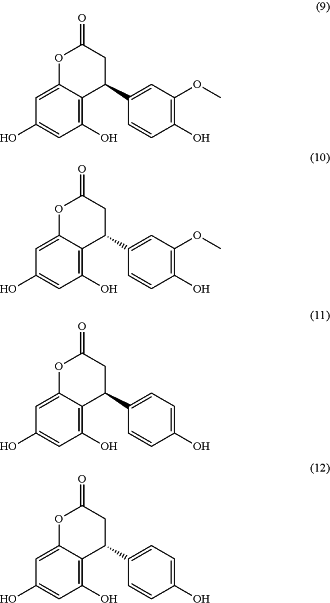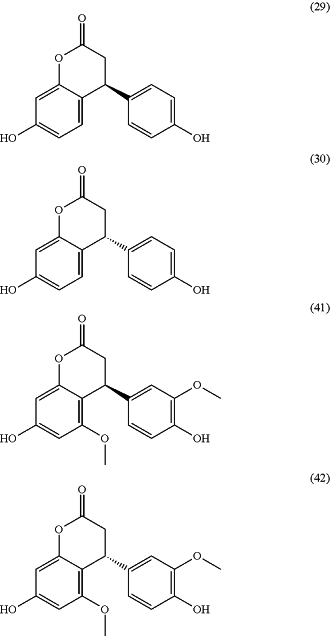| CPC A23L 27/2052 (2016.08) [A23L 27/204 (2016.08); A23L 27/84 (2016.08); A23L 27/86 (2016.08); A23V 2002/00 (2013.01); A23V 2200/16 (2013.01); A23V 2250/21162 (2013.01)] | 8 Claims |
|
1. A food product comprising:
(a) juice of HLB-infected oranges having both a sour taste and a bitter taste, wherein the juice comprises:
at least 3 ppm of limonin,
at least 5 ppm of polymethoxylated flavanones, and
at least 200 ppm of hesperidin,
(b) about 5 ppm to about 1,000 ppm of an enantiomeric mixture of neoflavonoids selected from:
(i) (9) (4S)-5,7-Dihydroxy-4-(4-hydroxy-3-methoxy-phenyl)chroman-2-on and
(10) (4R)-5,7-Dihydroxy-4-(4-hydroxy-3-methoxy-phenyl)chroman-2-on;
(ii) (11) (4S)-5,7-Dihydroxy-4-(4-hydroxyphenyl)chroman-2-on and (12) (4R)-5,7-Dihydroxy-4-(4-hydroxyphenyl)chroman-2-on;
(iii) (29) (4S)-7-Hydroxy-4-(4-hydroxyphenyl)chroman-2-on and (30) (4R)-7-Hydroxy-4-(4-hydroxyphenyl)chroman-2-on;
(iv) (41) (4S)-7-Hydroxy-4-(4-hydroxy-3-methoxy-phenyl)-5-methoxy-chroman-2-on and
(42) (4R)-7-Hydroxy-4-(4-hydroxy-3-methoxy-phenyl)-5-methoxy-chroman-2-on;
salts thereof, or mixtures thereof
  wherein the (S)-enantiomer and the (R)-enantiomer of the enantiomeric mixture of neoflavonoids are in a ratio of 1:1,
the limonin and the enantiomeric mixture are in a ratio of 1:1.3 to 1:3.6;
the mixture of neoflavonoids of (b) is in an amount that reduces the sour taste, reduces the bitter taste, and increases sweetness of the juice of the HLB-infected oranges of (a), and
the food product has a reduced sour taste, a reduced bitter taste, and increased sweetness compared to a comparative food product without the mixture of neoflavonoids of (b) but otherwise identical to the food product.
|